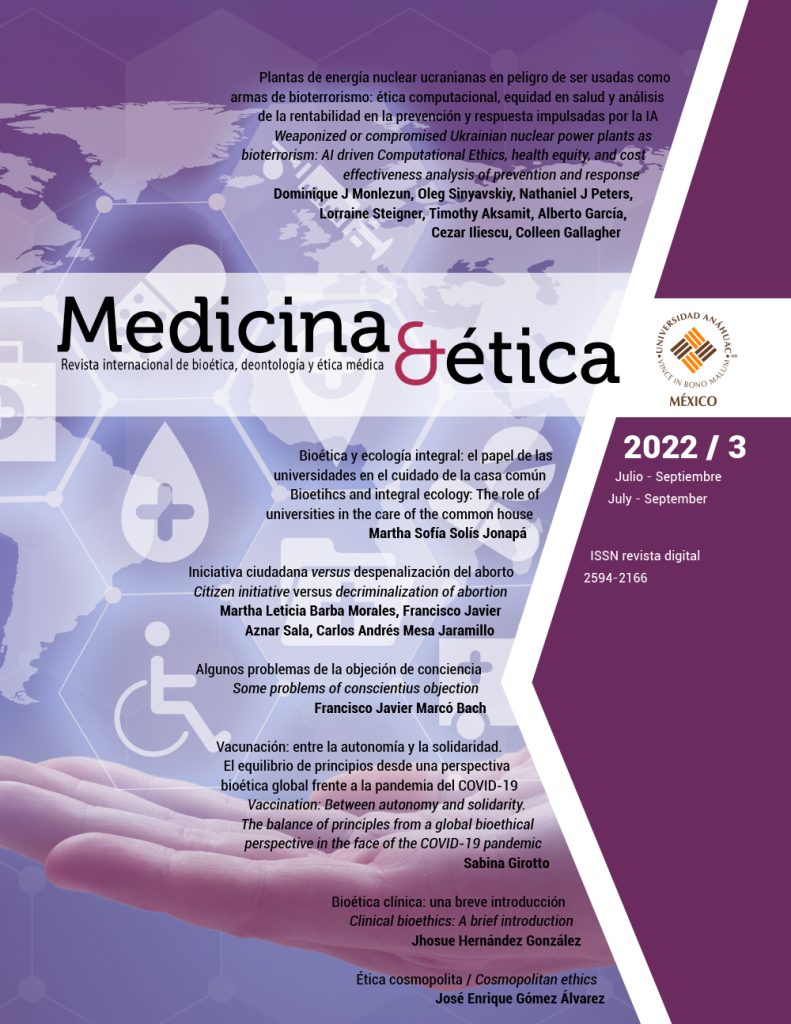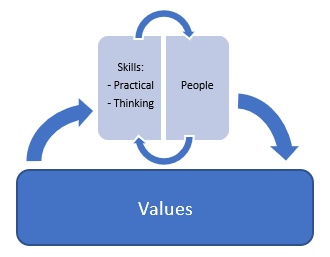8th International Bioethics, Multiculturalism and Religion Workshop
by Allister Lee, licentiate student in bioethics.
From September 20th to 23rd, the much anticipated 8th International Bioethics, Multiculturalism and Religion Workshop took place in Bangkok, Thailand. It was the first workshop since the hiatus caused by the pandemic, consequently, it was held both in person and virtually via Zoom. The workshop was organized by the UNESCO Chair in Bioethics and Human Rights in collaboration with the Chulalongkorn University.
The topic of this workshop was the importance of protecting the environment, biosphere, and biodiversity. The theme was chosen in light of the United Nations’ recognition that access to a clean, healthy, and sustainable environment is a human right. The aim of the workshop was to better understand how different traditions conceptualize the relationship between humanity and nature, and consequently the ethical approach to tackling the current climate issue. This year’s participants included scholars from traditions such as Christianity, Judaism, Islam, Hinduism, Secularism, Buddhism, Confucianism, and Daoism. Due to a change in methodology in this workshop, each academic had 15 minutes to present their paper, followed by a response by a scholar from a different tradition. Each exchange concluded with a 45-minute question and answer session from the audience.
The workshop opened with a series of speeches by Somsong Ngamwang, director of the Bureau of International Cooperation, Alberto Garcia, Dean of the Faculty of Bioethics and Chairholder of the UNESCO Chair in Bioethics and Human Rights (Pontifical Athenaeum Regina Apostolorum, Rome), Suradech Chotiudompant, Dean of the Faculty of Arts of Chulalongkorn University, and Joseph Tham, the coordinator of this workshop, all highlighting the need for public discourse about climate action from a religious perspective and also expressing gratitude to organizations that facilitated the workshop.
The first presentation was given by Luzita Ball, a trustee of the Islamic Foundation for Ecology and Environmental Science, representing the Islamic faith. In her presentation, Ms. Ball explained that according to the Qu’ran and the Hadiths, nature is a beautiful thing that is created by Allah and humanity has taken up the responsibility to be nature’s stewards (Khilaafah). To illustrate her argument, Ms. Ball points out the diversity both between and within species are signs (ayahs) of Allah’s beauty, intelligence, power, compassion, and love. With regard to Islam’s approach to managing the environment, the speaker provides two key arguments. First, she points out that is imperative for humanity to recognize the best outcome for both nature and men lies in true balance. As a result, when deliberating climate issues, one must take humanity and nature into equal consideration, so that the benefits of climate actions taken could be maximized. Secondly, Ms. Ball adds that there are existing systems in place in Islamic law, such as well-defined areas where the killing of wild animals and the harvesting of most vegetation is forbidden (Harim) or conservation zones (Hima) are used to protect the environment from over-exploitation and damage. To conclude her presentation, Ms. Ball highlighted the importance of environmental justice at all levels of society.
The response to Prof. Ball’s presentation was given by Prof. David Heyd, Professor of Philosophy at the Hebrew University in Jerusalem, from a secular Jewish perspective. He begins by describing Judaism as the “Sister Religion” of Islam on the basis of their similarities in content and teachings. However, Prof. Heyd highlights some key differences such as the proactivity of humanity taking responsibility for maintaining the earth within the Islamic tradition, whereas it was imposed on men in the Judaic tradition. Furthermore, he argued that the Judaic approach to nature is more anthropocentric to that of Islam because it focuses more on how God created the world so that men can benefit from it as a result.
The second session commenced with a presentation by Prof. John B. Appleby, lecturer in medical ethics at Lancaster Medical School on “Environmental Beneficence”. The idea of “Environmental Beneficence”, as Prof. Appleby describes, is the patient-physician decision-making framework that aims to give priority to sustainability while also preserving the quality of care provided to patients. He argues that this is necessary as the current state of healthcare negates the long-term effects of climate change on health and wellbeing. Prof. Appleby concludes his presentation by advocating for change in the classroom, clinics, and with the public, so that sustainability would be part of the everyday conversation when patients receive healthcare.
The response to Prof. Appleby’s paper was given by Prof. Roland Chia, Professor of Christian Doctrine at Trinity Theological College. He questions the lack of philosophical premises and metaphysical assumptions that underlies Prof. Appleby’s arguments, stating that there would be no ethics without some understanding of the world and the relationship between man and nature. Prof. Chia further provides the idea of “Environmental Beneficence” with a Christian metaphysics that recognizes the importance of considering the prosperity of future generations when making decisions about current issues.
In the afternoon of the first day, two keynote speakers, Henk Ten Have and Denis Chang, respectively gave presentations titled UNESCO on Environment and Integral Ecology, Natural Order & Relational Self: Towards a “Postsecular” Synthesis in an “Ecological Age”. Prof. ten Have framed workshop’s discussion by reinstating UNESCO’s position on protecting the environment and by emphasising the indispensable value of local wisdom and knowledge in creating a sustainable environment for future generations. Meanwhile, Prof. Chang’s presentation provided an overview of past and current philosophical approaches to understanding the role and responsibility of humans in relation to the environment. The speaker also highlighted one of the contemporary figures in climate action – Pope Francis and his encyclical Laudato Si’.
The afternoon roundtable featured Prof. Chris Durante, Prof. Vardit Ravitsky, Prof. David Barr, and Professor Sumalee Mahanarongchai. The traditions highlighted in this discussion include Orthodoxy, Secularism, Christianity (specifically Protestantism), and Thai Buddhism. Orthodoxy, as represented by Prof. Durante from Saint Peter’s University, considers humanity’s current failure to care for the environment as a moral one and categorises it as a sin. This categorisation is based on the panentheism of Orthodoxy, the belief that “all is in the Divine” and “the Divine is in all”. Prof. Durante concluded that the key to ending such sins against nature is through the transfiguration of self and community.
On the other hand, Prof. Ravitsky argued that despite human fallibility, societies have made great strides towards protecting the environment and there should be elements of rational optimism in the future of mankind. Meanwhile, Prof. Barr acknowledges that because of the fractured nature of Protestantism, its stance on the environment is equally splintered and susceptible to external influences such as political ideologies. Prof. Mahanarongchai’s response to Prof. Barr explores religion as a political tool that possesses its own hierarchies of power and how it can that affect policymaking by influencing politicians.
On the second day of the workshop, the participants turned their focus toward the Eastern traditions. The morning began with the Daoist tradition represented by Dr. Edmund and Christine Lai which called for a return to the Dao, harmony between heaven, earth, and human, by returning to authenticity through simplicity. In response to their presentation, Dr. Aasim Padela, Professor of Bioethics and Medical Humanities at The Medical College of Wisconsin, offered the monotheistic Islamic narration of creation, which also creates a hierarchy amongst creatures in contrary to Daoist beliefs.
Afterwards, the second round table of the morning focused on Confucianism as presented by Jonathan Chan, Former Professor of Centre for Global Studies, Shantou University. Prof. Chan puts forward the thought-provoking question that if the value of non-human living things is to be considered lower than humans, exactly how much lower are they? Is there a quantifiable way to make such assessment?
In the afternoon, a public discussion was held at Chulalongkorn University. The panel included Prof. Durante, Ms. Ball, Fr Anil Sakaya, and Prof. Ravitsky, moderated by Fr Tham. The panel discussed the emerging role of bioethics in the field of environmental science. The public discussion was attended by Buddhist monks representing a university in Bangkok and several external academics. The topics of discussion included whether intelligence in animals increases the value humans arbitrarily assigned to them to whether it is ethical to exterminate a whole species of mosquitoes to protect humanity from malaria.
The final day of the workshop began with the presentation by Prof. Ellen Zhang titled A Construction of Environmental Ethics from a Buddhist Perspective, in which she drew connections between the Mahāyāna and Theravāda branches of Buddhism. One of the key idea Prof Zhang presented was that because all things in this world are interconnected through a complex network, if one thing is destroyed, others will be affected as well. A response was made by Prof. Ruping Fan, who provided a Confucian argument that caring for the environment is a form of love, but of a lesser importance compared to the main tenets of Confucianist thought such as filial piety. The discussion continues as Fr Anil, a buddhist monk, gave a presentation focusing on the role of Thai monks in environment protection, for example, monks who collect plastic bottles to be made into robes. Furthermore, the presenter points out that while Buddhist teachings do not have specific content on the human imperative or responsibility to the environment, it is the duty of the devotees to exercise their consciences while using natural resources, with consideration to the constant state of change.
Lilian Santos, a bioethicist from the Pontifical Athenaeum Regina Apostolorum in Rome responded questioning whether Buddhism takes a stance on any other bioethical issues, such as artificial intelligence.
The second session of the morning was a panel discussing the Judaic approach to ethical environmental action. Prof. Jonathan Crane from Emory University discusses his proposal for non-anthropocentrism, the understanding that humans are to co-exist alongside all things nonhuman, and be equal to everything else in this world, “humans are but one bit in the vast unfolding cosmos”.
Prof. Paul Macneill from the University of Sydney responded to Prof. Crane’s paper questioning what are the practical terms of the duty that are described by Prof. Crane and who has responsibility to fulfill that duty within the non-anthropocentric framework. Alternatively, Prof. Macneill suggests that the Hindu tradition has always been anthropocentric, focusing on the suffering and enlightenment, and argues that a new approach is needed for religious environmental ethics.
The last roundtable of this workshop included Prof. John Lunstroth, Fr. Sameer Advani, Prof. R. R. Kishore, and Prof. Soraj Hongladarom, discussing environmental protection from the Hindu perspective. Prof. Lunstroth puts the term “religion” under scrutiny, arguing that Hinduism is actually a cosmological philosophy or a moral guide for daily life rather than a religion with clear and fixed doctrines. However, due to colonial expansion, attempts were made to mold Hinduism into a religion of nature in order to put it into a sort of category. Prof. Lunstroth goes on to argue that if considering Hinduism in its pre-colonial form, it appears to worship trees and animals despite the teachings of Ataiva, the oneness of all things.
In response to Prof. Lunstroth’s argument, Fr Advani questions not whether colonialism influenced the perception of religion in non-Western cultures, but rather “how profound, how fundamental, how transforming was that change”. This discussion was followed by Prof. Kishore outlining how Hinduism perceives the nature of the natural world through excerpts of key Hindu texts such as the Atharva Veda. The final presentation was given by Prof. Hongladarom, who has been critical to the success of this workshop. In his presentation, he compared and contrasted the Hindu tradition and the Thai Buddhist tradition, he pointed out that neither of these Eastern traditions believe that humans are in anyway superior to other living or non-living beings but rather only a part of the whole.
In conclusion, this workshop explored a wide range of ideas, from theological to political aspects of religion, and how they perceive humanity’s reasons to protect the environment and prevent further damage. As a participant of this workshop, I went away learning that protecting the environment is not a subject of dispute, but the debate of finding the most ethical and efficient way to go about doing so is one that will carry on in the foreseeable future.





